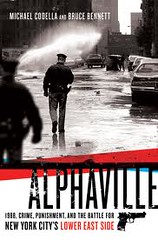 Alexa Tsoulis-Reay Mike Codella, a retired police officer, has turned his experiences working the streets of the East Village into a book, “Alphaville.”
Alexa Tsoulis-Reay Mike Codella, a retired police officer, has turned his experiences working the streets of the East Village into a book, “Alphaville.”After dumping some stuff in my locker, I decided to take a drive around my new beat. What I saw was shocking. Even though it was January and one of the coldest days so far that year, there were dope deals taking place on nearly every corner I passed. Junkies and dealers shivered together, exchanged dope and money and parted company. A group of users followed one after the other into an abandoned building lobby being used as a “toilet” or a designated spot to shoot up indoors.— “Alphaville,” pg. 127
On a recent Saturday afternoon, Mike Codella steered his car from Avenue D onto East Houston Street. “This place used to be like a volcano, but look how quiet it is now,” he said, surveying the territory of the beat he patrolled as a New York City plainclothes detective at the height of the drug wars in the 1980s. “The further east you went, there was an atmosphere, something was always about to explode, and it usually did,” he said, throwing his hands up in the air.
From 1986 to 1991 Mr. Codella — his nickname is Rambo — patrolled Alphabet City. He has turned his memories into a gritty, nonfiction book, “Alphaville,” co-authored by former East Village resident Bruce Bennett.
Mr. Codella left the Alphabet City beat back in the early 1990s and went on other posts in the NYPD. On 9/11, he rushed to help police officers and was trapped for a time in the South Tower of the World Trade Center. When he retired in 2003, the box of memories he had quietly filed away over the years spilled over. “I’d hear cops telling stories and I’d think you call that a story? I got some stories!” The result: “Alphaville,” published this week.
Mr. Codella now lives in Staten Island, where he runs a Jiu Jitsu academy, a good fit since he holds a black belt. The compact, muscular retired officer returned to his old stomping grounds recently to take me on a tour of some of the most memorable sites from his time policing Avenue D.
East Second Street and Avenue D
Roughly 25 years ago a drug-hungry mass queued up waiting to place orders as if it were an express-takeout window. Mr. Codella says dealers and junkies barely attempted to conceal what was happening. On one occasion, he removed his hat and casually took a place in line. The incident resulted in four arrests.
A uniformed police officer patiently queuing to score heroin? The image is so surreal it is almost impossible to imagine. That scene summarizes the atmosphere that cloaked Alphabet City back in the 1980s. “Drugs were just so visible,” says Mr. Codella.
Jacob Riis/Lillian Wald Houses
We drove down Avenue D in his Honda Accord, with mini-boxing gloves swaying from the rearview mirror, as Mr. Codella made a sharp turn left onto East Sixth Street which cuts through the Jacob Riis and Lillian Wald housing developments. He pointed across FDR Drive, toward the green-space that sits on the edge of the East River. The park was a hot spot for heroin sales, and arrests were made when customers returned back past the traffic, either high or their bodies laced with soft bags of contraband. He recalls one memorable arrest of a college professor who had just scored in the park. “He thought he was so smart. He put the drugs inside his closed umbrella. But I just knew he was dirty.” When Mr. Codella opened the umbrella 15 bags of heroin tumbled out. “He was what you call a functioning junkie.” The East Village was full of them, he says.
The Observation Room/ Avenue D and East Third Street
Hidden behind black security bars in a ground floor apartment, Mr. Codella used to covertly survey the corner of Avenue D and East Third Street, where dealers made sales. People commuted from around New York and across the country to spirit drugs back to their neighborhood. Mr. Codella says that children would have to weave between junkies waiting to purchase. “It was the best heroin and it was available. This area was never dry,” he said.
As we turned to leave, Mr. Codella was greeted by a man dressed in a low-cut tank top and half unzipped hooded sweatshirt. Mr. Codella lowered his shades and the pair exchanged warm greetings. Afterwards, Mr. Codella explained that the man is someone that he had arrested in the late ’80s for selling heroin.
For the rest of the drive, Mr. Codella pointed out other landmarks and related more tales of his time on Avenue D, including a particularly gruesome story involving a man who beat up two acquaintances with a baseball bat.
“It happened right there,” he said, nonchalantly pointing to a street corner as the muffled sounds of a gospel choir floated out of a nearby church. How did he cope with all the violence? “I guess you get used to it. Or, I dunno, you just didn’t talk about it,” he said.




